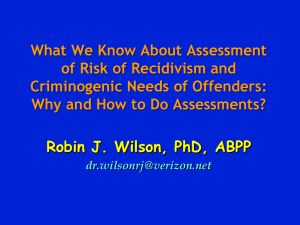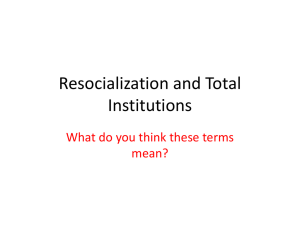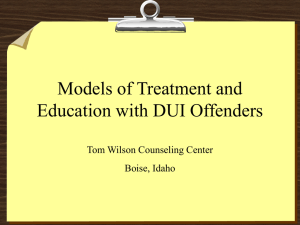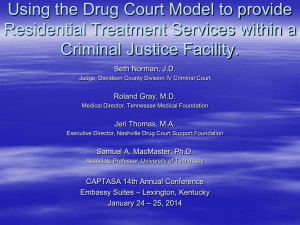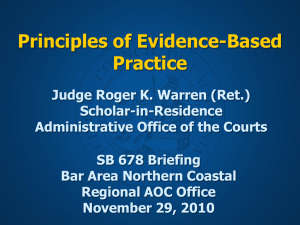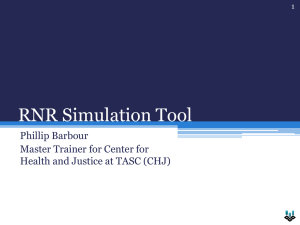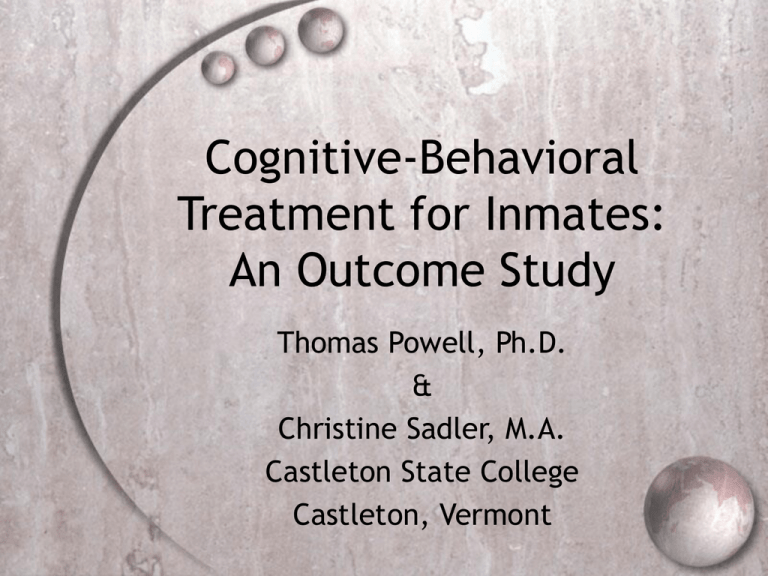
Cognitive-Behavioral
Treatment for Inmates:
An Outcome Study
Thomas Powell, Ph.D.
&
Christine Sadler, M.A.
Castleton State College
Castleton, Vermont
Vermont Department of
Corrections
Administration and management of prisons,
jails, community release, parole and
probation.
Mission explicitly promotes rehabilitative
opportunities within the context of public
safety and victims’ rights.
Vermont Department of
Corrections
Vt.DOC has one of the highest per capita
incarceration growth rates in the U.S.
despite the fact that …
Vermont has the second lowest violent
crime rate in the U.S.
Vermont Department of
Corrections
Pervasive overcrowding has been the result of
sentencing legislation, “get-tough” judicial
appointments, and a poorly regulated pattern of
PO’s returning parolees to prison for technical
breeches and infractions.
500 Vt. inmates have been displaced (outsourced)
to private prisons in Kentucky and Oklahoma).
If ever there were a case for managed care …
Cognitive Self-Change
Program
Originally based on techniques proposed by
Yochelson & Samenow and Ross & Fabiano.
“Bad habits of the mind” are more responsible for
criminal conduct than social circumstances (William
Healy, 1915).
Jack Bush has been the program director since its
inception in 1988.
Cognitive Self-Change
Program
Pro-criminal thinking patterns become
ingrained, automatic and reflexive.
CSC is designed to bring thinking habits and
patterns under the offender’s conscious
and deliberate control.
Cognitive Self-Change
Program
Program participants learn to objectively observe
and report their thinking without justification.
They identify the linkages between their specific
thinking patterns and their antisocial conduct.
They rehearse and practice alternative thinking
patterns, using actual events in their lives.
Extensive use of journaling and role plays.
Cognitive Self-Change
Program
Groups meet formally twice weekly for 3 hours.
Inmates stay in the program for eight to 24
months, usually depending on sentence length.
At the three largest prison sites it is provided in
the context of a therapeutic unit. It is also
provided at the women’s prison and most
probation/parole offices.
Cognitive Self-Change
Program
CSC is a core designated “risk-reduction program”
for Vermont inmates.
Any inmate who is convicted of a crime of violence
or aggression and given a sentence of eight months
or more is likely to have this in his/her case plan.
Cognitive Self-Change
Program
In most cases the nature of the crime (presumed
violence) and the length of sentence are the only
factors weighed by caseworkers is assigning an
inmate to the program.
Principles of risk, need and responsivity are
generally ignored in favor of one-size-fits-all
program requirements.
Inmate Assessment
The LSI-R is administered to all inmates, but it is
only used (total score) to determine whether
institutional program participation will be
required for non-violent offenders. There is no
evidence of its use as a case planning tool for any
group of inmates.
There are no other assessment procedures to
determine eligibility and appropriateness of the
inmate for the CSC program.
Present Study
What recidivism rates are observed for inmates
who participate in the CSC program?
What is the optimal dosage (time in program) as a
function of an individual’s risk level (LSI-R score)?
Is there any evidence of improvement in
recidivism rates for low risk inmates required to
participate?
Treatment Dosing
Total number of cognitive self-change
hours (in institutions and field sites):
Low dosage: 1-65 hours
Medium dosage: 66-150 hours
High dosage: < 151 hours
Recidivism Measures
•
The number of days an offender was
incarcerated after being released from a
correctional facility. Measured at 12 and
24 months post-release.
•
The number of new post release criminal
charges.
Participants
Sample of convenience.
403 inmates identified retrospectively through Vt. DOC’s
management information system.
Sixteen females were removed; final sample 387.
All subjects were exposed to all least some level of CSC
treatment. No unbiased no-treatment group could be
identified in the database due to design limitations.
Participants
Racial composition: > 90% Caucasian (n =351).
Age range: 21 to 68 years of age at time of release.
Average number of offenses leading to guilty conviction
was 5.4 (SD = 3.7). Forty-one percent of the sample had
more than five charges.
Virtually all the subjects were convicted of at least one
violent crime or sex crime.
Risk Assessment
LSI-R total: M = 26.5 (SD = 6.7) with a range
of 7 to 46.
Recidivism
The average number of incarceration days
for the first year post-release was 60 (SD =
88.7) ranging from 0-361 days.
42% had no incarceration days; 58% had at
least one.
Recidivism
The average number of incarceration days
for the second year post-release was 79 (SD
= 120) ranging from 0-365 days.
50% had no incarceration days.
Multivariate Results
One-way between-subjects MANOVA was used to
determine the relationship between CSC dosing
and recidivism with CSC level as the IV, and
number of days incarcerated during the first year,
number of days incarcerated during the second
year and number of charges as the DVs.
Bivariate correlations among DVs ranged from .28
to .57, p < .01.
Multivariate Results
Significant main effect for CSC level; Wilks’Λ = .941, F(1,
386) = 3.94, p = .001, partial η2 = .03.
Significant effect for recidivism in the first year, F (2,
385) = 5.35, p = .005, partial η2=.027 with offenders in
the high dose category spending fewer days in jail than
the medium dose category.
There was a statistically significant effect for the second
year F(2, 385) = 3.210, p = .041, η2=.016, but post-hoc
tests did not reveal differences among means.
No statistically significant effect for number of charges.
Number of incarceration days during the first year
post-release X CSC dosage
Incarceration days
Mean
SD
Low
59.64
91.69
Medium
77.98 a
95.03
High
42.38 a
72.37
Note. Subscripts denote statistically significant differences (Tukey HSD p = .005)
Multivariate Results
One-way between-subjects MANCOVA controlling for LSI-R
score to determine if recidivism was a function of risk
score.
Covariate was significant; Wilks’ Λ = .952, F(3, 384) =
6.391, p < .0001, partial η2=.05.
Significant effect for recidivism in the first year; F(6, 381)
= 3.56, p = .002, partial η2=. 03.
Significant effect also found for second year; , F(1, 386) =
9.14, p =.003.
Multivariate Results
Follow-ups for CSC dosage demonstrated a
significant main effect for recidivism for
the first year only F (2, 385) = 3.819, p =
.023, partial η2=.02
Offenders in the high dosage group were
less likely to spend time in jail than the
medium dose group.
120
Nummber Of Days Spent in a Correctional Facility
Year 2
100
Year 1
80
Year 2
Year 2
Year 1
60
Year 1
40
20
0
Low
Medium
High
Cognitive Self-Change dosing level
Fig 1. Days spent in a correctional facility, post release, as a function of CSC
dosing level
Limitations
Positively skewed data
Low internal consistency of LSI-R scores
Lack of comparison group
Lack of information regarding seriousness of
recidivism (e.g. misdemeanor/felony/technical)
Unreliable data entry by field facilitators
Unknown treatment progress ratings
Demographics of sample
Policy Questions
Knowledge destruction is alive and well.
Inclusion of low risk cases in CSC probably had no
demonstrable benefit, and it may have had an iatrogenic
effect.
With bed space at a premium and DOC budget increases
draining funds from other human service programs, there is a
need for a managed care approach to the use of long term
mandatory treatment.
Contact Information
Thomas Powell tpowell@vtfa.com
Christine Sadler
christine.sadler@castleton.edu

